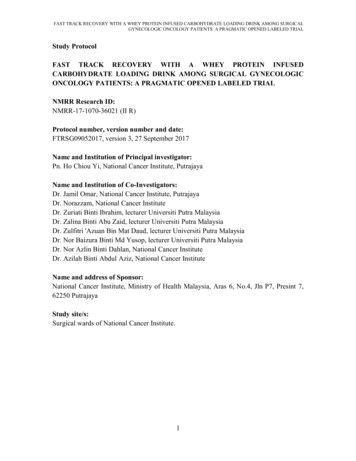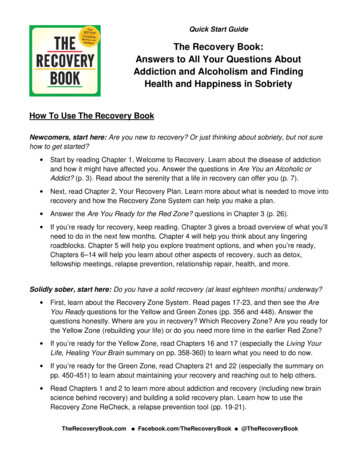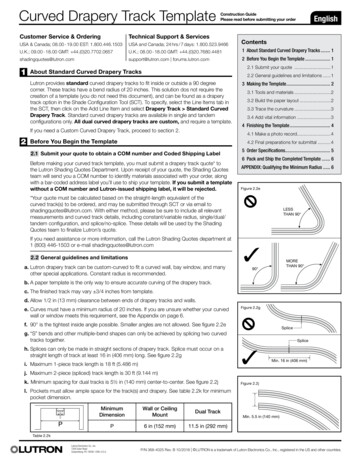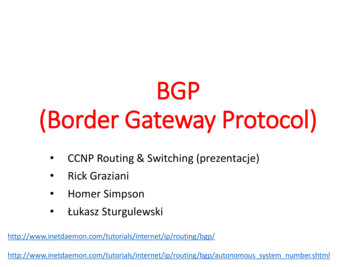
Transcription
FAST TRACK RECOVERY WITH A WHEY PROTEIN INFUSED CARBOHYDRATE LOADING DRINK AMONG SURGICALGYNECOLOGIC ONCOLOGY PATIENTS: A PRAGMATIC OPENED LABELED TRIALStudy ProtocolFAST TRACK RECOVERY WITH A WHEY PROTEIN INFUSEDCARBOHYDRATE LOADING DRINK AMONG SURGICAL GYNECOLOGICONCOLOGY PATIENTS: A PRAGMATIC OPENED LABELED TRIALNMRR Research ID:NMRR-17-1070-36021 (II R)Protocol number, version number and date:FTRSG09052017, version 3, 27 September 2017Name and Institution of Principal investigator:Pn. Ho Chiou Yi, National Cancer Institute, PutrajayaName and Institution of Co-Investigators:Dr. Jamil Omar, National Cancer Institute, PutrajayaDr. Norazzam, National Cancer InstituteDr. Zuriati Binti Ibrahim, lecturer Universiti Putra MalaysiaDr. Zalina Binti Abu Zaid, lecturer Universiti Putra MalaysiaDr. Zulfitri 'Azuan Bin Mat Daud, lecturer Universiti Putra MalaysiaDr. Nor Baizura Binti Md Yusop, lecturer Universiti Putra MalaysiaDr. Nor Azlin Binti Dahlan, National Cancer InstituteDr. Azilah Binti Abdul Aziz, National Cancer InstituteName and address of Sponsor:National Cancer Institute, Ministry of Health Malaysia, Aras 6, No.4, Jln P7, Presint 7,62250 PutrajayaStudy site/s:Surgical wards of National Cancer Institute.1
FAST TRACK RECOVERY WITH A WHEY PROTEIN INFUSED CARBOHYDRATE LOADING DRINK AMONG SURGICALGYNECOLOGIC ONCOLOGY PATIENTS: A PRAGMATIC OPENED LABELED TRIALList of oLFTRCOCHO-PNational Cancer RegistryBody Mass IndexInstitut Kanser NegaraLength of Hospital StayPatient Generated Subject Global AssessmentAbridge Patient Generated Subject Global AssessmentHemoglobinBody Fat MassAlbuminC-Reactive ProteinQuality of lifeFast Track RecoveryControl groupCarbohydrate-whey protein2
FAST TRACK RECOVERY WITH A WHEY PROTEIN INFUSED CARBOHYDRATE LOADING DRINK AMONG SURGICALGYNECOLOGIC ONCOLOGY PATIENTS: A PRAGMATIC OPENED LABELED TRIALResearch SynopsisStudy titleStudyPopulationStudy hesisPrimaryOutcomeSecondaryoutcomeSample SizeStudyDurationFast Track Recovery With A Whey Protein Infused Carbohydrate LoadingDrink Among Surgical Gynecologic Oncology Patients: A PragmaticOpened Labeled TrialAll patients who has been diagnosed with gynecologic oncology andundergoing surgery treatment at National Cancer Institute, Putrajaya.Pragmatic opened labeled trial. Participants will be randomly divided intocontrol & intervention group during admission to hospital using randomnumbers. Participants were randomized into two groups: the carbohydrateprotein (CHO-P) group and conventional (CO) group. Participants weregiven a specific drink to their group on the evening prior to surgery andthree hours before operation. The CHO-P group received 474ml (eveningdrink) or 237ml (3hours prior to operation drink) of a solution contain 14%whey protein, 86% carbohydrates and 0% lipids and the CO group nil-bymouth at 12 midnight day of operation. All participants fasted for solids for6 hours from the operation.To determine the impact of fast track recovery feeding with a whey proteinplus carbohydrate drink in Surgical Gynecologic Oncology Patient inNational Cancer Institutea. To compare post-operation outcome between CHO-P group andconventional group.b. To compare anthropometric, biochemical and functional databetween CHO-P group and conventional groupc. To determine relationship between fast track recovery feeding witha whey protein plus carbohydrate drink and post-operative outcomeThis hypothesis predicts there is improvement in post-operation outcome ofintervention group if compare with control group of surgical gynecologiconcology patients undergoing surgery treatment in National CancerInstituteLength of hospital stay, length of clear fluid toleration, length of solid foodtoleration, length of flatus, length of bowel openWeight, fat percentage, muscle mass, PG-SGA, CRP, Albumin, handgripstrength106 subjects14 months3
FAST TRACK RECOVERY WITH A WHEY PROTEIN INFUSED CARBOHYDRATE LOADING DRINK AMONG SURGICALGYNECOLOGIC ONCOLOGY PATIENTS: A PRAGMATIC OPENED LABELED TRIALINTRODUCTIONCancers is group of diseases which involve growth of abnormal cells. Normally, cellsgrow, divide and then die. Sometimes, cells mutate. They begin to grow and divide morequickly than normal cells. Rather than dying, these abnormal cells clump together to formtumors. Gynecologic oncology is a specialised field of medicine that focuses on cancersof the female reproductive system, including ovarian cancer, uterine cancer, vaginalcancer, cervical cancer, and vulvas cancer (Disaia et al. 2017).Gynecological Cancer iscancers that effect woman’s reproductive system. Other types of gynecological cancersinclude fallopian tube cancer and placenta cancer (a pregnancy-related cancer) (Disaia etal. 2017).In 2009, 16,437 Australians females lived with Gynecological Cancer, where4919 new cases of Gynecological Cancer were diagnosed in year 2011. GynecologicalCancer had become the 3rd most commonly diagnosed cancer among females inAustralia (Australian Institute of Health and Welfare 2014). Global Cancer Statistics(2012) shows that most common diagnosed cancer in females is cervix uteri besidesstomach and colorectal cancer and become 3rd leading cause of death in females in lessdeveloped countries with 90% of cervical cancer death occurred in developing parts ofthe world. National Cancer Registry Report (2014), Cervix Uteri and Ovary cancer werein 10 most leading cancer and in 5 most common cancers in Malaysian females from year2007 to 2011. There were a total of 847 cases of cervix cancer diagnosed in 2007registered at National Cancer Registry (NCR). The incidence rate of cervical cancerincreased after 30 years old and peaks at ages 65-69 years. When we compared amongthe major races, Indian women had the highest incidence for cervical cancer followed byChinese and Malay. 45% of females at the point of first diagnosis with cervical cancerwere already at stage 3 and 4.Cancer cells alter energy metabolism which increase resting energy expenditureand increase metabolism of sugar, protein and lipid. Cancer patients includinggynecological cancer patients’ high risk being malnourished before start on anytreatment. Nutrition requirement for surgery is higher if compared with normalrequirement in order to support speedy recovery. For patient who went for surgerytreatment, length of hospital stay (LOS) of patient after surgery may be affected impairedby nutritional status of a patient pre and post-operation. In a cohort study done inAustralia among 157 Gyneacological Cancer (GC) patients, the data shows thatmalnutrition, low QoL scores and being diagnosed with advanced ovarian cancer are themajor determinants of LOS amongst GC patients. Intervention addressing malnutritionand poor QoL may shorten LOS in GC patients (Laky et a. 2010). LOS has becomesurrogate marker for patient’s well-being during hospital treatment and identifying4
FAST TRACK RECOVERY WITH A WHEY PROTEIN INFUSED CARBOHYDRATE LOADING DRINK AMONG SURGICALGYNECOLOGIC ONCOLOGY PATIENTS: A PRAGMATIC OPENED LABELED TRIALpretreatment factors associated with LOS in surgical patients may enable earlyintervention in order to reduce postoperative LOS (Lay et al. 2010; Caro et al. 2007).Cancer and its treatment result in severe biochemical and physiological alterationsassociated with a deterioration of QoL (Maria et al. 2007).Like other cancers, first step of gynecological cancer management includes cancerdiagnosis where clinical and pathological assessments taking place. Once a diagnosis andcancer stage is confirmed, oncologists determine treatment options and prognosis and toapply the appropriate research treatment protocols. The primary modalities of cancertreatment are surgery, chemotherapy and radiotherapy; these may be used alone or incombination (Feig et al. 1998). For those cancers which are well margined and operable,surgery is first treatments for gynecological cancer (Vetto et al. 1999).Surgery, a like injury, causes skeletal muscle tissue to be broken down in order torelease amino acids. These amino acids are transported to the wound to promote woundhealing. Anabolism, where increased protein synthesis to repair the damaged cells as wellas new blood vessels, requires protein. Optimum nutritional status peri-operation canspeed up wound healing, improve immunity and ensure the better post-surgery outcome.Other than calories and carbohydrate, protein is crucial for post-surgery recovery andpromotes anabolism, slows down muscle catabolism and decreases the inflammatoryphase (Averd et al. 2017). Source of whey protein includes legume, dairy products andmeat. Whey protein is a high quality protein that is easier to be digested and stimulatesmuscle protein synthesis if compared to casein. These effects may be due to the highdegree of branched-chain amino acids in whey protein which directly stimulates the earlycellular process involved in protein synthesis called initiation translation (Kimball et al.2002). However, some people who are allergic to milk may be specifically allergic towhey protein. In moderate doses, whey protein does not typically cause any adverseevents but consuming very high doses can cause stomach pains, cramps, reducedappetite, nausea, headache and fatigue (Vonk et al. 2003).Conventional feeding strategy for pre- and post-operation whereby prolongedfasting or rest for both the patient and the gastrointestinal tract will delay the recovery ofpatients since the organic response to surgical trauma is enhanced by prolonged period offasting. Inadequate oral intake due to delayed oral feeding caused depletion of nutrientstorage in patient’s body. This is because of utilization of energy which converted fromprotein source of body (muscle). This metabolism process is called catabolism. Patientsexperienced weight loss and muscle mass loss post-operatively (Balayla et al. 2004;Balayla et al. 2005).5
FAST TRACK RECOVERY WITH A WHEY PROTEIN INFUSED CARBOHYDRATE LOADING DRINK AMONG SURGICALGYNECOLOGIC ONCOLOGY PATIENTS: A PRAGMATIC OPENED LABELED TRIALConventional surgery approach was questioned by professor of surgery, HenrikKehket (1999). Hence, Kehket et al. (1999) developed multimodal perioperative protocol,named Enhanced Recovery After Surgery or Fast Track Recovery Surgery protocol. As akey of fast track recovery (FTR) programs also include a metabolic strategy to reduceperioperative stress and improve outcomes. Nutrition intervention post operation isimportance. Studies of FTR program in gynecology surgery have shown that suchprograms significantly reduce length of hospital stay and consequently have positiveeconomic benefits without increasing readmission and complication rates. To achievethese goals, FTR programs focus primarily on reducing perioperative stress, achievingsatisfactory pain control, resumption of normal gastrointestinal function and earlymobilization (Balayla et al. 2004; Balayla et al. 2005; Obermair et al. 2017; Ester et al.2016; Averd et al. 2017).1.2 Problem statementWhile early oral feeding is preferred mode of nutrition, avoidance of anynutritional support therapy bears the risk of underfeeding during postoperative courseafter major surgery. To abbreviate preoperative fasting, beverage containingcarbohydrates have been used and recommended in FTR program. Formula containingprotein on top of carbohydrate-enriched drink proposed to improve post-operative musclestrength, reduce fatigue, anxiety and discomfort as well as lowering the endocrinemetabolic response to trauma. Whey protein contains a high level of essential aminoacids especially branch-chain amino acids. These amino acids are rapidly used by skeletalmuscle during stress and highly stimulate protein synthesis. Whey protein has a highdegree of digestibility and rapid absorption in the small bowel. No study so far has aimedto examine the benefits of whey protein in the composition pre-operative and postoperative drinks among surgical gynecologic oncology patients.Research Questions:1. What are the nutritional status (anthropometry, dietary intake, muscle mass,handgrip strength and biochemical data such as CRP, serum albumin andhemoglobin level) in surgical gynecologic oncology patient in National CancerInstitute?2. What are the post-operative outcomes (length of bowel function, length of solidfood toleration and length of stay) in surgical gynecologic oncology patient inNational Cancer Institute?3. What are the differences in post-operation outcome between CHO-P group andcontrol group?4. Is there any relationship between fast track recovery feeding with a whey proteinplus carbohydrate drink and post-operative outcome?6
FAST TRACK RECOVERY WITH A WHEY PROTEIN INFUSED CARBOHYDRATE LOADING DRINK AMONG SURGICALGYNECOLOGIC ONCOLOGY PATIENTS: A PRAGMATIC OPENED LABELED TRIAL1.3 Objective1.3.1 General ObjectiveTo determine the impact of fast track recovery feeding with a whey protein pluscarbohydrate loading drink in Surgical Gynecologic Oncology Patient in National CancerInstitute1.3.2 Specific objectivea. To compare post-operation outcome between CHO-P group and conventionalgroup.b. To compare anthropometric, biochemical and functional data between CHO-Pgroup and conventional groupc. To determine relationship between fast track recovery feeding with a wheyprotein plus carbohydrate drink and post-operative outcome1.4 Null Hypothesis1. There is no difference in post-operation outcome between CHO-P group andconventional group2. There is no relationship between fast track recovery feeding with a whey proteininfused carbohydrate loading drink and post-operative outcome7
FAST TRACK RECOVERY WITH A WHEY PROTEIN INFUSED CARBOHYDRATE LOADING DRINK AMONG SURGICALGYNECOLOGIC ONCOLOGY PATIENTS: A PRAGMATIC OPENED LABELED TRIALConceptual FrameworkMethodology2.1 Study DesignPragmatic opened label trial to investigate the impact of fast track recovery feeding withwhey protein plus carbohydrate drink on surgical gynecologic oncology patients inNational Cancer Institute.This study will focus on impact towards post-operativeoutcome when whey protein contained pre-operative drink is taken in current standardoperating procedure in managing surgical gynecologic oncology patients2.2 Study PeriodRecruitment and intervention period is months, 1st September 2017 to 31st October 2018.2.3 Study PopulationAll surgical gynecology patients receiving surgery treatments in National CancerInstitute, Putrajaya Inclusion criteriaa. Those who diagnosed with Gynecologic Cancer stage 1 to stage 4b. Candidates for elective operation treatments8
FAST TRACK RECOVERY WITH A WHEY PROTEIN INFUSED CARBOHYDRATE LOADING DRINK AMONG SURGICALGYNECOLOGIC ONCOLOGY PATIENTS: A PRAGMATIC OPENED LABELED TRIALc. Malaysian who aged more than 18 years old Exclusion Criteriaa. Not a candidate for elective operation treatmentsb. Aged 18 years oldc. Diagnosed with Diabetes Mellitus/Chronic Kidney Disease/Cardiovasculardisease/Chronic liver diseased. Not able to provide informed consente. Allergy to milk/soy/whey protein2.4 Sample SizeSample size estimation was calculated using two population means formulae48. Prior dataindicate that the mean hospital stay of the control group was 9 (standard deviation 6.5)and the mean of intervention group was 5.6 (standard deviation 2.35)51. Thus, aminimum sample size of 33 samples per group to be able to reject the null hypothesiswith probability (power) 0.8. The Type I error probability associated with this test of thisnull hypothesis is 0.05. The independent t-test statistic will be used to evaluate this nullhypothesis. With an additional of 30% dropout rate, the sample size is 53 samples pergroup.9
FAST TRACK RECOVERY WITH A WHEY PROTEIN INFUSED CARBOHYDRATE LOADING DRINK AMONG SURGICALGYNECOLOGIC ONCOLOGY PATIENTS: A PRAGMATIC OPENED LABELED TRIAL2.5 Withdrawal CriteriaSubjects may be withdrawn if the investigator deems that it is detrimental or risky for thesubject to continue. Subjects also can withdrawal themselves in the middle of this studywithout any reason. Withdrawn subjects will not be replaced.2.6 Study Tools and ParametersAll parameters and variable data will be collected throughout monitoring period and willbe recorded in Data Collection Form and aPG-SGA Scoring Sheet.Patient Generated Subjective Global Assessment (PG-SGA) is a nutritionalassessment tool that can identify risk of malnutrition among cancer patients. It includesmore nutritional symptoms than the one in SGA sheets, short term weight loss andnumerical scoring which may reflect clinical changes over time [27]. PG-SGA componentcontain first four parts questionnaires reflecting history of weight and weight lost, foodintake, NIS and functional ability that must be filled by patient him or herself. The nextpart of PG-SGA need to be filled by professionals contains assessment of metabolicdemands, nutrition and disease requirement and physical exam. Abridge PG-SGA oraPG-SGA used only the first four parts questionnaire of original PG-SGA that are proveto be sufficient to be used as a useful tool for early detection and predicting outcome ofcancer cachexia as shown in a cohort study with advanced cancer patients [28]. This studyshows that a high score of aPG-SGA is significantly associated with lower Hb level,increased WBC Count, decreased anthropometry and physical measurement such as BMI,BFM and Handgrip Strength, a dose reduction in chemotherapy and increased mortality[28].Valid measurement tools are scheduled calibrated Tanita Total Body CompositionAnalyser model SC 300 which can provide body weight in kg (up to 0.1kg), fatpercentage (up to 0.1%), total muscle mass (up to 0.1kg). Subject is requested to haveminimal clothing, empty pocket and stand up-right with bare foot on metal plate of scale.Scheduled calibrated SECA Height Measurement (up to 0.1cm) is used to measuredheight. Subject needs to be bare foot, stand up-right and face front while measuring.Handgrip strength is measured on the non-dominant hand using Jamar handdynamometer (Fred Sammons Inc, Burr Ridge, Illinois, USA). Handgrip strength as asurrogate marker for muscle strength in patients with cancer has been well documentedelsewhere. Subjects sit with their shoulder adducted and neutrally rotated, elbow flexed at90º, forearm in neutral position, and standard verbal instructions are given to the subjects10
FAST TRACK RECOVERY WITH A WHEY PROTEIN INFUSED CARBOHYDRATE LOADING DRINK AMONG SURGICALGYNECOLOGIC ONCOLOGY PATIENTS: A PRAGMATIC OPENED LABELED TRIALto squeeze the dynamometer as hard as possible for three times after an interval of 5seconds in between grips. Average of three successive attempts is used as the final result.The variables that being collected in the Data Collection Form are:1. Socio-Demographica) Ageb) Ethnic Groupc) Education Leveld) Occupation2. Pre-operative dataa) Anthropometric Data: Weight, Height, Muscle massb) aPG- SGA Scoringc) Diet Recall via Dietary Assessment Sheetd) Handgrip strengthe) Biochemical data: Hemoglobin (Hb), C-reactive protein and Albumin (Alb)3. Post-operative Outcomea) Length of Hospital Stayb) Length of bowel functionc) Length of solid food toleration2.7 Study FlowCandidates will attend Multidisciplinary Clinic (MDC) as appointment date forexamination then they will get surgery appointment (admit to ward) 7-14 days after MDCdate. Eligible patients will be identified from name list available in the electronic medicalrecord. Selection of patient will be done by assigned research team member then she willapproach and inform with study procedures to all potential candidates (selected based oninclusion and exclusion criteria) while they attend MDC during study period. Participantswill be randomized into two groups: the carbohydrate-protein (CHO-P) group andconventional (CO) group during admission to hospital via random numbers which areissued by computer program. For the concepts of the CONSORT flow diagram arefollowed [50]. The Patient Information Consent Form will be given to identify eligiblesubjects who agreed to be recruited in the study. Subjects are allowed to bring backconsent form if she keen to seek advice from family member.Carbohydrate-protein group: Participants will attend dietitian clinic to haveanthropometry & dietary assessment on the same day of admission (before admission).Subjects are given a specific drink to their group on the evening prior to surgery and threehours before operation. The CHO-P group received 474ml (evening drink) or 237ml (3hours prior to operation drink) of a lactose-free clear tea-colour fruit flavoured fluid11
FAST TRACK RECOVERY WITH A WHEY PROTEIN INFUSED CARBOHYDRATE LOADING DRINK AMONG SURGICALGYNECOLOGIC ONCOLOGY PATIENTS: A PRAGMATIC OPENED LABELED TRIALcontains 14% whey protein, 86% carbohydrates and 0% lipids. Participants fast for solidsfor 6 hours from the operation. Participants will be given clear fluid (2 packs Resourcepeach) within 24 hours post-surgery (without present of bowel sound) and reviewed bydietitian. Staff nurse in-charged will monitor anesthetic risk of drinking whey protein andensure subject to finish specific drinks prior surgery. When they tolerated at least 500mlof clear fluids, they were given a regular solid diet.Conventional group: Participants will attend dietitian clinic to have anthropometry &dietary assessment on the same day of admission (before admission). Participantsfollowed conventional operation procedure whereby fasting start 12am until operation.On the first day of post-operation day, participants will be reviewed by gynaecologist anddietitian. They are allowed for clear fluid once there is bowel sound. After tolerated clearfluid, they will proceed for nourishing fluid, then soft diet and they were given a regularsolid diet.On the day of operation and on the first day of post-operative day, blood samplesare collected for hemoglobin, renal profile, albumin and C-reactive protein. Biochemicaldata will be record from electronic medical record. Upon discharge, all participants willbe sent to dietitian clinic to assess anthropometry and dietary data.12
FAST TRACK RECOVERY WITH A WHEY PROTEIN INFUSED CARBOHYDRATE LOADING DRINK AMONG SURGICALGYNECOLOGIC ONCOLOGY PATIENTS: A PRAGMATIC OPENED LABELED TRIALFlow Chart of Research ActivitiesStartScreening of patient in MDC, IKNScreening of patient willbe done based oninclusion and exclusioncriteria.Randomized samplingConventional group (CO)Intervention Group (FTR)Admission 2-3 days prior surgery&assessment in diet clinic before admissionAdmission 2-3 days prior surgery&assessment in diet clinic before admissionSolid food (High Protein High Calories diet)during dinner evening before surgerySolid food (High Protein High Calories diet)6 hours before surgery-Nil-by-mouth 12am onwards474ml specific drink as evening drink237ml specific drink 3 hours beforesurgerySurgerySurgeryPost operative assessment and managementwhereby nil by mouth until bowel sound,passage of stool or flatus and subjectivesensations of hunger were present the diettransition fashionAfter surgery, subjects will be given specificdrink on the first post-operation day. Whenthey tolerated at least 500ml of specificdrink, they were given a regular solid diet.Upon discharged, subjects will be sent to diet clinic to assessanthropometric & dietary dataDischarge homeEnd*Collection data will be collected prior totreatment and through study period.13
FAST TRACK RECOVERY WITH A WHEY PROTEIN INFUSED CARBOHYDRATE LOADING DRINK AMONG SURGICAL GYNECOLOGIC ONCOLOGY PATIENTS: A PRAGMATICOPENED LABELED TRIAL2.8 Study Duration and Timeline2017FEBMARAPRMAYJUNE JULYAUGSEPTOCTLiterature reviewDraft proposal &other documentsNMRR applicationModificationonstudy proposalStudy initiationData collection andQCData entryData cleaningData analysisReport writingPresentationThe participation duration for each subject is minimum 1 week until patient is discharged14NOVDECJANSEPT2018OCT NOVDEC
FAST TRACK RECOVERY WITH A WHEY PROTEIN INFUSED CARBOHYDRATE LOADING DRINK AMONG SURGICALGYNECOLOGIC ONCOLOGY PATIENTS: A PRAGMATIC OPENED LABELED TRIAL3.10 Statistical Analysis PlanEnergy and macronutrient from diet recall will be analyzed by Axxya system programNutritionist Pro. This is diet analysis and nutrition food label software. Food in diet recallis entered into system then system will analyze and show total energy, macronutrientsand micronutrient intake in kilocalories, gram and microgram."The analyses will be performed using IBM SPSS Statistics for Windows(Version 22.0. Armonk, NY: IBM Corp.). Descriptive statistics will be utilized forselected variables. The results will be presented as frequencies and percentage forCategorical Data. Numerical Data which is normally distributed will be presented asmean and standard deviation while median and interquartile range will be presented forNumerical Data which is not normally distributed.Comparing Numerical Data which is normally distributed between two groupswill be analyzed using the Independent t-test while Mann-Whitney test will be used if notnormally distributed. Pearson's Chi-square test for Independence will be used to studyassociation between Categorical Data and Categorical Data while Fisher's exact test willbe used if assumptions of Pearson's Chi-square test for Independence are not met.Multiple logistic regressions will be used to study association between risk factors(Numerical Data/Categorical Data) and outcomes (Categorical Data). All probabilityvalues will be used two-sided and a level of significance of less than 0.05 (p-value 0.05) will be considered as statistically significant (Lang & Secic, 2006).The aim of a clinical trial is to make a calculated judgement about the likely clinicaleffectiveness results that would be seen if the treatments tested were to be used for allsuitable patients. The eligibility criteria for a patient entering a clinical trial shouldensure that they are representative of patients suitable for the treatments being tested andcompared. In a randomised trial, the set of all randomised patients is known as the‘intention to treat population’, or the ITT population. This clinical trial study populationis intended to represent suitable patients and to be reflective of what might be seen if thetreatment was used in clinical practice. Therefore the ITT population should normally bethe basis for inferences about the effectiveness of the treatments.The eligibility criteria for the ITT population and treatments they receive will beclearly defined in the study protocol but in practice not everything goes perfectly to plan.Therefore, we need to plan ahead for the inconsistencies that can occur, for example,because of human error, and consider how we deal with them statistically.15
FAST TRACK RECOVERY WITH A WHEY PROTEIN INFUSED CARBOHYDRATE LOADING DRINK AMONG SURGICALGYNECOLOGIC ONCOLOGY PATIENTS: A PRAGMATIC OPENED LABELED TRIALOne deviation from the protocol that is often experienced is when the allocated treatmentis not actually received by all randomised patients; sometimes patients receive the wrongtreatment or incomplete treatment. These things can, however, also happen to patients inclinical practice so they should not result in patients’ exclusion from the evaluation madeon the ITT population. For this same reason, patients should be analysed according totheir planned (intended) treatment and not the actual treatment they received.16
FAST TRACK RECOVERY WITH A WHEY PROTEIN INFUSED CARBOHYDRATE LOADING DRINK AMONG SURGICALGYNECOLOGIC ONCOLOGY PATIENTS: A PRAGMATIC OPENED LABELED TRIALREFERENCESAustralian Institute of Health and Welfare 2014. Cancer in Australia: an overview, 2014.Cancer series no. 78. Cat. No. CAN 75. Canberra: AIHW.National Cancer Registry Report, Malaysian Cancer Statistics-Data and Figure, 2007Global Cancer Statistics, 2012: Lindsy A. Torre, MSPH; Freddie Bray, Rebecca L.Siegei, Jacques Ferlay, JoannieLortet-Tieulaent, AhmedinJemal, CA: A cancer Jurnal forClinician, Vol 65, Issue 2, 4 Feb 2015 (Wiley Online Library)Vanessa Fuchs-Turlovsky,Karolina Alvarez-Altamirano, Deborah Turquie-Sacal,Carolina Alvarez- Flores, Hellen Hernandez-Steller. Nutritional status and bodycomposition area already affected before oncology treatment in ovarian cancer. Asia PacJ ClinNutr 2013;22 (3):426-430American Dietetic Association (2010) International dietetics and nutrition terminology(IDNT) reference manual, 3rd edn. American Dietetic Association, Chicago.Davies M (2005) Nutritional screening and assessment in cancer-associated malnutrition.EurJ OncolNurs 9(suppl 2):S64–S73Leandro-Merhi VA, de Aquino JL, Sales Chagas JF (2011) Nutrition status and riskfactorsassociated with length of hospital stay for surgical patients. JPEN J ParenterEnteral Nutr35:241–248Marin Caro MM, Gomez Candela C, Castillo Rabaneda R, Lourenco Nogueira T,GarciaHuerta M, Loria Kohen V et al (2008) Nutritional risk evaluation andestablishment of nutritionalsupport in oncology patients according to the protocol of theSpanish Nutrition andCancer Group. NutrHosp 23(5):458–468Morley JE (2009) Calories and cachexia. CurrOpinClinNutrMetab Care 12(6):607–610Van Cutsem E, Arends J (2005) The causes and consequences of cancer-associatedmalnutrition.Barrera R (2002) Nutritional Support in cancer patients. JPEN J Parenter Enteral Nutr26(suppl 5):S63-S71.doi:10.1177/014860710202600516Laky B, Janda M, Bauer J,Vavra C. Cleghorn G, Obermair A (2007) Malnutrition ):642646.doi:10.1038/sj.ejcn.1602540Van Cutsem E, Arends J (2005) The causes and consequences ofcancer-associatedmalnutrition. Eur J OncolNurs 9(Suppl 2):S51–S63. doi:10.1016/j.ejon.2005.09.00717
FAST TRACK RECOVERY WITH A WHEY PROTEIN INFUSED CARBOHYDRATE LOADING DRINK AMONG SURGICALGYNECOLOGIC ONCOLOGY PATIENTS: A PRAGMATI
Kehket (1999). Hence, Kehket et al. (1999) developed multimodal perioperative protocol, named Enhanced Recovery After Surgery or Fast Track Recovery Surgery protocol. As a key of fast track recovery (FTR) programs also include a metabolic strategy to reduce perioperative stress and improve outcomes. Nutrition intervention post operation is










